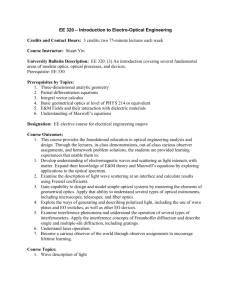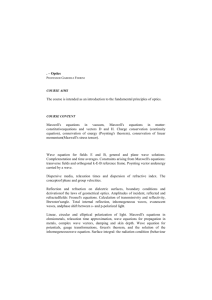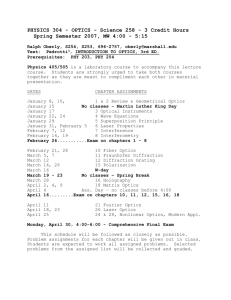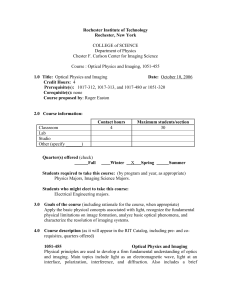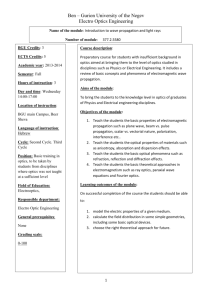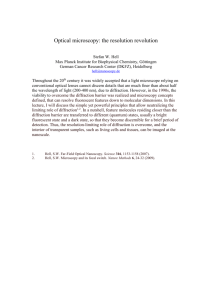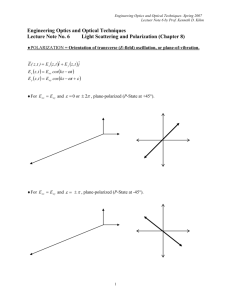Lecture Note No. 8
advertisement
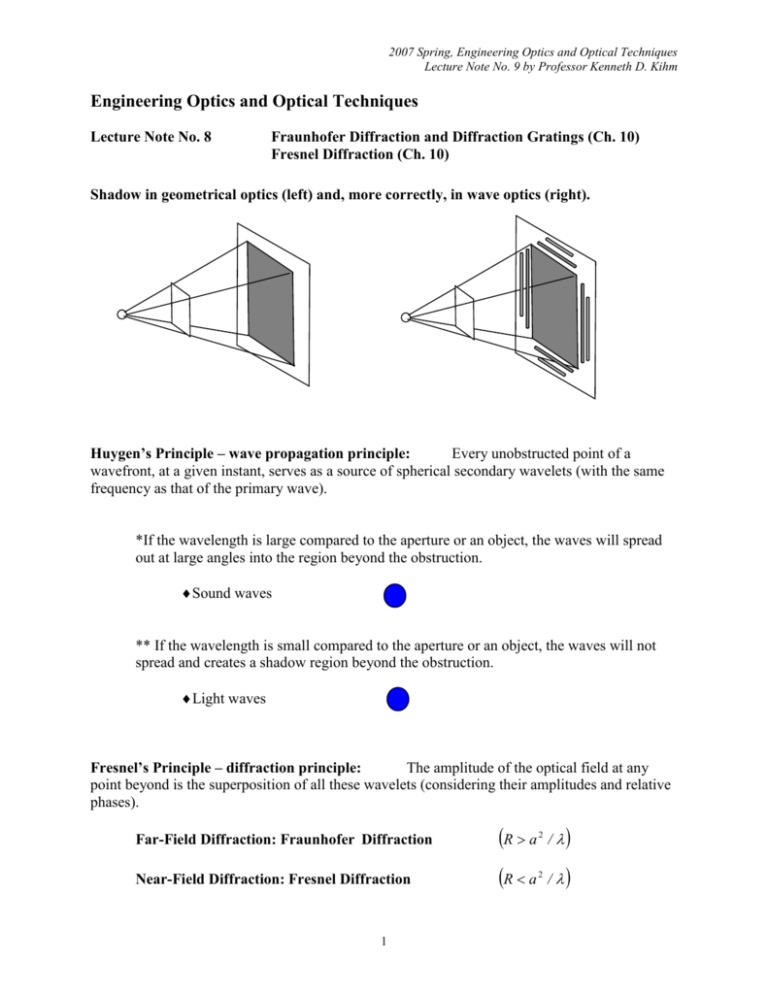
2007 Spring, Engineering Optics and Optical Techniques Lecture Note No. 9 by Professor Kenneth D. Kihm Engineering Optics and Optical Techniques Lecture Note No. 8 Fraunhofer Diffraction and Diffraction Gratings (Ch. 10) Fresnel Diffraction (Ch. 10) Shadow in geometrical optics (left) and, more correctly, in wave optics (right). Huygen’s Principle – wave propagation principle: Every unobstructed point of a wavefront, at a given instant, serves as a source of spherical secondary wavelets (with the same frequency as that of the primary wave). *If the wavelength is large compared to the aperture or an object, the waves will spread out at large angles into the region beyond the obstruction. Sound waves ** If the wavelength is small compared to the aperture or an object, the waves will not spread and creates a shadow region beyond the obstruction. Light waves Fresnel’s Principle – diffraction principle: The amplitude of the optical field at any point beyond is the superposition of all these wavelets (considering their amplitudes and relative phases). Far-Field Diffraction: Fraunhofer Diffraction R a 2 / Near-Field Diffraction: Fresnel Diffraction R a 2 / 1 2007 Spring, Engineering Optics and Optical Techniques Lecture Note No. 9 by Professor Kenneth D. Kihm CIRCULAR APERTURE (radius a) 2 J ka sin Airy function: I I 0 1 ka sin 2 I() D q R I(0) a Image plane Aperture or lens I / I 0 3.83 7.02 ka sin Airy disk is sized by ka sin 2 a q 3.83 R 3.83 R R f 1.22 1.22 decreases with 2a 2a D increasing aperture diameter D, and increases with increasing wavelength . The radius of the brightest center spot q 2 2007 Spring, Engineering Optics and Optical Techniques Lecture Note No. 9 by Professor Kenneth D. Kihm DIFFRACTION-LIMITED IMAGING The aperture diameter is analogous to the lens diameter for imaging or collimating parallel beam. The Airy ring is considered as the focal point image, which is formed by Fraunhofer diffraction principle. The central maximum of one Airy ring image coincides with the first minimum of the other, resolution is marginal. [Rayleigh’s criterion] min lmin f Thus, the resolution limit, l min Airy disk radius 1.22 f 1.22 and min 1.22 D NA D lmin decreases with decreasing f and , and with increasing D. Example: 3 2007 Spring, Engineering Optics and Optical Techniques Lecture Note No. 9 by Professor Kenneth D. Kihm DIFFRACTION GRATINGS for Spectrometer/Monochromator Diffraction by many (N) slits (Section 10.2.3), b: slit width a: slit separation sin I I o 2 sin N sin 2 where dimensionless separation, a b sin and dimensionless slit width, sin . The first parentheses term is the square of sinc function shown in Fig. 10.10, which represents the slit width effect, and the second parenthesis also modulates representing multiple slit effects as shown in Fig. 10.17. The modulation by multiple slits, the second parentheses term, becomes zero or minimum contribution whenever N k k or , k = 1, 2, 3, … N Except when 0, , 2 ,... or k = 0, N, 2N, … , mN (The second term = 1.0: Principal Maxima) Thus, between any two adjacent maxima, N-1 minimum intensity points exist. The Principal Maxima condition is a sin m and a sin m 4 (refer to Fig. 10.16) 2007 Spring, Engineering Optics and Optical Techniques Lecture Note No. 9 by Professor Kenneth D. Kihm Monochrometer/Spectrometer Principle Diffraction grating equation: a sin m a m m , and the PM becomes more distinct a with larger N or N/unit length (or smaller slit separation a). Note that m increases with increasing and the local peaks will be more distinctive with larger N. Therefore, Principal Maxima occurs at m ~ The angular dispersion of spectrometer is given as, d m m … Spectrometer resolution increases with increasing m and decreasing a. ~ d a Schematic of Spectrometer 5 2007 Spring, Engineering Optics and Optical Techniques Lecture Note No. 9 by Professor Kenneth D. Kihm Resolvance of Spectrometer Resolvance: Nm Resolution: 1 Nm Principal maximum of the m-th order is given for the first wave and the second wave , respectively, as a sin m (1) a sin m The resolvance will be limited when the PM of the second wave overlaps with the first dark band of the first wave, i.e., a 1 sin m N (2) Combining (1) and (2) gives an expression for the resolution as, 1 Nm and the resolvance, the reciprocal of the resolution, is given as Nm 6 2007 Spring, Engineering Optics and Optical Techniques Lecture Note No. 9 by Professor Kenneth D. Kihm Ex.1: When looking through a diffraction grating at a hydrogen discharge tube, which emits light of 656 nm wave length, we see two red lines, to either side of the zeroth order. If at a distance of 90 cm from the grating, the two lines are separated by 62.5 cm, how many lines per millimeters does the grating have? Ex. 2 The sodium D doublet has wavelength of 589 nm and 589.6 nm. If only a grating with 400 rulings/mm is available, what is the lowest order possible in which the D lines are resolved? 7 2007 Spring, Engineering Optics and Optical Techniques Lecture Note No. 9 by Professor Kenneth D. Kihm Obliquity or Inclination Factor K( ) … Prelude to Fresnel or near-field Diffraction * Spherical wave front should be considered since the length scale from the light source to the aperture may be relatively small, whereas planar waves were considered for Fraunhofer diffraction because of larger length scales. The optical disturbance at (t = t’), created by the source S, is described as a harmonic spherical wave, i.e., E o cost' k and the disturbance at P (t = t) resulting from a source element dS on the spherical wave front is, therefore, dE P K A r cos t k r dS K Kirchhoff formulation (Sec. 10.4) gives 1 1 cos 2 K 1 8 = 1 at = 0 = 0 at = for Fraunhofer Diffraction ( 0 since S P >>1) 2007 Spring, Engineering Optics and Optical Techniques Lecture Note No. 9 by Professor Kenneth D. Kihm Fresnel Diffraction Optical Disturbance (E-Field) Generated by Unobstructed Spherical Wavefront E-field at the wave front at t = t’ is given as E o cos t' k , o : source strength The contribution of the optical disturbance at P from the spherical wave front of dS is given as dE K A r cost k r dS A : source strength per unit area at the wave front (1) where the obliquity K is assumed constant over a single Fresnel zone. The geometrical analysis (p. 487) shows dS 2 ro rdr (2) Carrying out the integral of dE, Eq. (1), with dS, Eq. (2), for the l-th Fresnel zone [ rl 1 , rl ; K l ] gives El 1 l 1 2K l A sint k ro ro where the E-field has alternative signs. 9 (3) 2007 Spring, Engineering Optics and Optical Techniques Lecture Note No. 9 by Professor Kenneth D. Kihm Successively it can be shown (p. 488) that E E1 E2 ... Em E1 2 Thus, the disturbance synthesized from secondary wavelets is given frim Eq. (3) as, E K1 A sin t k ro ro Alternatively, considering the wave directly propagating from S to P, the resulting disturbance is expressed as, E o ro cost k ro *By equating these two with K1 ~ 1, we have A o 1 Eo . *The / 2 phase differential between the two (their cosine and sine modulations) reflects that the secondary sources re-radiate one-quarter of a wavelength out-of-phase with the primary wave. 10 2007 Spring, Engineering Optics and Optical Techniques Lecture Note No. 9 by Professor Kenneth D. Kihm The Vibration Curve Considering the first Fresnel zone to be divided by N-subzones, each subzone phasor is shifted by / N rad since the phase difference across the entire zone, from O to its edge, is rad (corresponding to / 2 ). dE K A r cost k r dS Phase: kr 2r with 0 The chain of phasors (Fig. 10.39) deviates slightly inward from the circle because increases and the obliquity factor gradually shrinks at each successive amplitude. The whole curve will be a smooth spiral curve with N (Fig. 10.40). The spiral ends at the mid-point of E1 since the total disturbance arriving at P from an unobstructed spherical wave is 1/2 E1 . 11 2007 Spring, Engineering Optics and Optical Techniques Lecture Note No. 9 by Professor Kenneth D. Kihm Circular Apertures Spherical wavefront should be considered since the lengthscale from the light source to the aperture may be relatively small. A circular aperture is identical to an obstructed spherical wave by a screen containing a small hole (Fig. 10.42). E at P ranges from ~0 to E1 as qualitativly shown in the vibration curve. The whole diffraction pattern can be mapped as the sensor is moved around (Fig. 10.43). Integration of dS 2 ro rdr for an l-th Fresnel zone rl ro l / 2, rl 1 ro l 1 / 2 gives the area of each zone as Sl ro ro … constant for all the zones. and the number of zones for the aperture of radius R is Nf R 2 Sl ro R 2 ro … increases with R 2 . Since the number of zones increases with the aperture size, the diffraction patterns show more number of ring-like modes with increasing aperture size. (p. 493) Circular Obstacle If the circular or spherical obstacle obscures the first l zones, the resulting disturbance at P along the optical axis is given (similar to the unobstructed case), E El 1 (See Fig. 10.45) 2 12 2007 Spring, Engineering Optics and Optical Techniques Lecture Note No. 9 by Professor Kenneth D. Kihm Rectangular Aperture The freely propagating spherical wave from the source to the aperture, via dS, is given as dE p K A r cost k r dS K recalling A o cost k r dS r o 1 Eo from p. 10. Using the derivation and magic (!) shown in p. 498, the irradiance at P is given as Ip 1 ~ ~* I o Cu2 Cu1 2 S u 2 S u1 2 Cv2 Cv1 2 S v2 S v1 2 Ep Ep 2 4 I p y1 , y 2 , z1 , z 2 : , ro , o , o 2 where I o is the unobstructed irradiance at P, u y ro 1/ 2 2 and v z ro 1/ 2 . The Fresnel integrals (Table 10.2) are defined as w C w cos w' / 2 dw' 2 w and 0 S w sin w' 2 / 2 dw' 0 where C w Cw , S w S w , and lim C w lim S w 0.5 w 13 w 2007 Spring, Engineering Optics and Optical Techniques Lecture Note No. 9 by Professor Kenneth D. Kihm Example: For a 2-mm square aperture, = 500 nm, OP = 4m, calculate the intensity at P(0,0) and P’(-0.1 mm,0). Ip Io 1 C u2 C u1 2 S u2 S u1 2 C v2 C v1 2 S v2 S v1 2 4 2 u y ro 1/ 2 2 , v z ro 1/ 2 C w Cw , S w S w , and lim C w lim S w 0.5 w P’ 14 P w 2007 Spring, Engineering Optics and Optical Techniques Lecture Note No. 9 by Professor Kenneth D. Kihm Cornu Spiral (Fig. 10.50) The arc length measured along the curve, dl, is equal to dw. Recalling Ip 1 ~ ~* I o C u 2 C u1 2 S u 2 S u1 2 C v2 C v1 2 S v2 S v1 2 EpEp 2 4 Io C u iS u uu12 4 2 C v iS v vv12 2 15 2007 Spring, Engineering Optics and Optical Techniques Lecture Note No. 9 by Professor Kenneth D. Kihm Fresnel Diffraction by a Slit = 500 nm ro = 4 m y1 , y2 Ip Io C u 2 C u1 2 S u 2 S u1 2 C v2 C v1 2 S v2 S v1 2 4 Io C u iS u uu12 4 2 C v iS v vv12 2 For u1 ,u2 , the first term becomes 2, and Ip Io Cv iS vvv12 2 2 … see Fig. 10.54 16 2007 Spring, Engineering Optics and Optical Techniques Lecture Note No. 9 by Professor Kenneth D. Kihm Semi-Infinite Opaque Screen: z 2 y1 y2 , i.e., v2 u2 and u1 Ip 1 ~ ~* I o C u 2 C u1 2 S u 2 S u1 2 C v2 C v1 2 S v2 S v1 2 EpEp 2 4 I o 4 2 2 2 2 1 1 2 1 1 2 1 1 I o 1 1 C v S v C v S v 1 1 1 1 2 2 2 2 2 2 2 2 2 17 2007 Spring, Engineering Optics and Optical Techniques Lecture Note No. 9 by Professor Kenneth D. Kihm Homework Assignment #9 E-o-C problems: Ch. 10-25, 28, 51, 52, 54, and the following three special problems. SP-1: A grating has 8000 slits ruled across a width of 4 cm. What is the color of the light whose two fifth-order maxima are 90 apart? SP-2: Collimated light containing the wavelengths 600 nm and 610 nm is diffracted by a plane grating ruled with 60 lines to the millimeter. If a lens of 2 m focal length is used to focus the light on a screen, what is the linear distance between these two lines in the first order? SP-3: The spectrum of mercury contains, among others, a blue line of 435.8 nm and a green line of 546.1 nm. If these two lines are to have an angular separation of at least 7, and if the grating available has 500 lines/mm, in which order must the grating be used? Due by April 10, 2006 18

